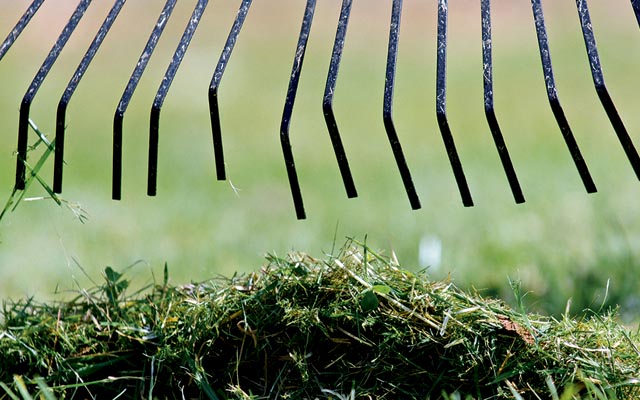How to prepare the lawn for summer growth
Scoring on home turf.


Getting the lawn back into shape at this time of year is a job I relish. There is a deal of satisfaction to be had in turning a tired, mudpat-spattered, weedy, worm-cast-ridden sward into something with more than a hint of emerald velvet.
First comes a light raking with a scarifying machine or, on smaller areas, with a wire-toothed rake. Scarifying is frequently undertaken as an autumn job, but, if you didn’t get round to it then, there is no harm in doing it now—especially as moss has grown apace this last winter.
The action of the springy, wire teeth will break up the worm-casts as well as pulling out the thick rug of moss and dead grass or ‘thatch’. Both serve no useful purpose and will crowd out the living blades. The mass of detritus that is removed (usually astonishing in its quantity) can be piled onto the compost heap and mixed in.
On heavy soils, follow the raking with some spiking to relieve compaction and improve drainage. This is another job that is often recommended as an autumn task and hollow-tine aeration certainly is best undertaken then. But, if tramping over a lawn through the winter has produced a surface that is impervious to water, spiking it now will help to shift summer downpours more rapidly.
A machine can be hired, although, at its most basic, aeration can involve simply stabbing a garden fork into the lawn at 6in intervals, wiggling it about and repeating the process over the entire area. Confine it to particularly compacted areas if you like and, in extreme circumstances, sweep sharp sand into the interstices.
When these two mechanical operations are complete, mowing to reduce the height of the grass blades to about 1in will ready the lawn for a square meal, but let it grow for a week or so before you treat it with anything at all.
For those who are not of the organic persuasion, the method is fairly straightforward: an application of combined lawn weedkiller and fertiliser. But there are dangers lurking, the most common of which is uneven application. Apply too much—or apply the weed-and-feed in a prolonged dry spell—and the grass will become scorched, taking weeks to regain its verdure. Miss areas and your lawn will possess light- and dark-green strips, with the lighter green areas being starved of nourishment.
Exquisite houses, the beauty of Nature, and how to get the most from your life, straight to your inbox.
However, if the stuff is applied evenly just before rain is forecast, all will be well. This is most easily ensured by using a wheeled distributor. One can be bought or hired and will quickly repay any outlay by avoiding expensive over-application. Keep your eye on a particular object in the distance as you travel and your lines will be straight.
Organic gardeners like myself, who don’t like to see blackbirds feeding their young on worms pulled from lawns that have been treated with herbicide, have to learn to live with clover and the like, grubbing out daisies and plantains by hand or else turning a blind eye.
Blood, bone and fishmeal is my lawn food of choice and I still apply it with a wheeled distributor to ensure even application. Its effects in terms of feeding the grass are surprisingly long lasting.
Then, it’s all down to the mowing once a week at least, in spring and summer, to ensure a thick, even sward; twice a week in periods of rapid growth. Raise the height of cut in dry spells to ensure greater drought tolerance, but don’t be tempted to leave the clippings on the lawn. They will do it no good whatsoever.
Watering? There’s no need for it, except on lawns that have been newly sown or turves that are newly laid. Established lawns recover rapidly from drought and we can all do our bit for household economy as well as for the environment by saving the water for the plants that really need it.
Country Life is unlike any other magazine: the only glossy weekly on the newsstand and the only magazine that has been guest-edited by His Majesty The King not once, but twice. It is a celebration of modern rural life and all its diverse joys and pleasures — that was first published in Queen Victoria's Diamond Jubilee year. Our eclectic mixture of witty and informative content — from the most up-to-date property news and commentary and a coveted glimpse inside some of the UK's best houses and gardens, to gardening, the arts and interior design, written by experts in their field — still cannot be found in print or online, anywhere else.
